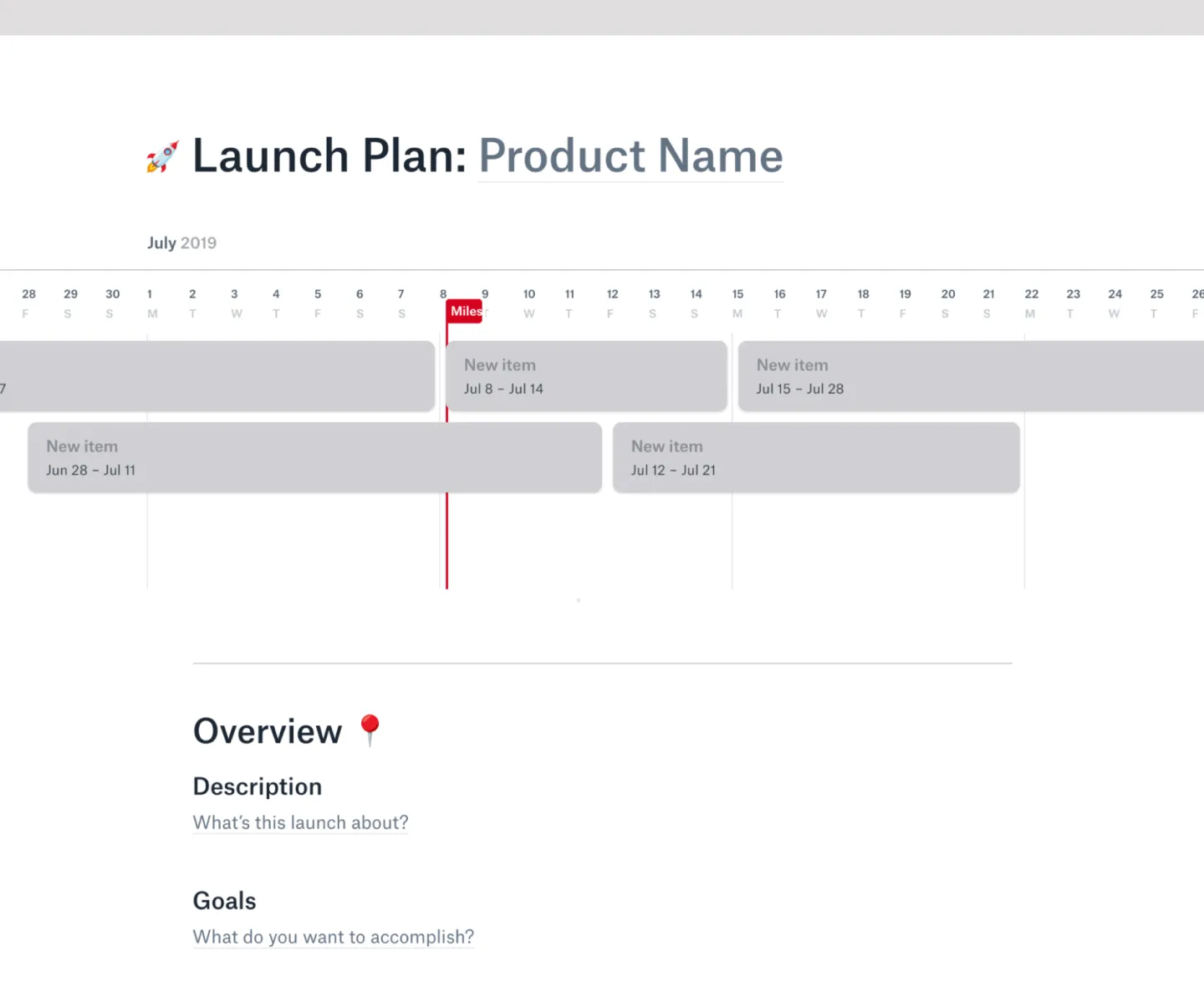When working on complex projects, it can be difficult to define success—especially when there’s a lack of consensus among your team.
Sometimes, your team doesn’t need any grand or overly technical interventions to achieve objectives—instead, clear and actionable parameters like SMART goals can be far more effective.
Learn everything you need to know about SMART goals with our comprehensive guide, starting with our SMART goals definition.
What are SMART goals?
SMART is a framework for setting Specific, Measurable, Achievable, Relevant, and Time-bound goals. It’s a goal setting criterion that helps to increase your team members’ chances of hitting their targets. Helping your team members set and reach goals is one of the best ways to keep motivation high, provide ongoing feedback, and connect individual workloads to wider corporate objectives.
SMART goals definition
SMART is an acronym used to optimize goal setting within your business, particularly when it comes to project planning and management, marketing campaigns, performance management, and personal development.
So, what does the acronym stand for? Well, it’s worth pointing out that different sources use the letters to refer to different things, so you can expect to see some variation between different versions of SMART. However, the SMART criteria is generally understood to be:
- Specific
- Measurable
- Achievable
- Relevant
- Time-bound
Let’s take a look at each of these in more detail.
Specific
Generic goals won’t cut it. Instead, you need to be specific and unambiguous about what you want to achieve. Think about the "w" questions: who, what, when, which, and why. Consider:
- Who needs to be involved?
- What are you trying to accomplish?
- When do you need to accomplish it?
- Which obstacles or requirements are you facing?
- Why are you setting this goal?
Feel free to get as granular as possible in your responses.
Measurable
You need to have specific criteria that you can use to measure your progress toward accomplishing this goal. When making a measurable goal, consider which metrics you’re going to use and set milestones for when you want to achieve specific targets.
Achievable
Is the goal attainable? Investigate whether the goal can really be achieved, weighing the time, effort, and costs against the benefits, as well as other priorities you may have within the business.
You should also think about what it would take to achieve this goal, and whether you have the necessary tools or skills at your disposal. If not, how difficult would it be to attain them? There’s not necessarily anything wrong with setting audacious targets, but if there’s no realistic hope of achieving them, it may be a good idea to reevaluate the objective.
Relevant
Think about the relevance of the goal within the wider organization. Is it reasonable and realistic, given your resources? Is it results-based?
For example, if you need to train yourself on a new piece of accounting software, consider the relevance of this software to your job and to the business at large. Similarly, if you’re launching a new product line, consider how this aligns with the strategic goals of the business.
Time-bound
Timing is everything. You need to provide a target date and ask specific questions about what can be accomplished within this time frame. Ensure the deadlines are realistic, yet flexible. While a sense of urgency is important, turning goal setting into a race against the clock isn’t likely to be beneficial for team members or the company as a whole.
What are SMARTER goals?
When you’re reading about SMART goal setting, you may also come across the term SMARTER goals. The SMARTER system is an extension of SMART, just with two added letters: Evaluate and Readjust.
Put simply, the addition of these two letters allows you to analyze and improve upon the SMART methodology, so you can take full advantage of the process. Continuously evaluate your goals, and if you find that you’re encountering problems on a regular basis, readjust.

What are the benefits of SMART goals?
SMART objectives ensure that clarity and focus remain a significant part of the goal setting process. After all, vague goals without a clear roadmap can be readily ignored, whereas specific goals are more likely to be taken seriously.
The SMART framework helps you figure out what’s important to achieving your goals, and how to go about doing this. It’s simple, easy to understand, and doesn’t require expensive tools—just effective collaboration and strong teamwork. This means that virtually any organization can benefit, from global titans and driven startups to small mom-and-pop stores.
"Measurable" is a key element of the process, meaning it’s easy to monitor. As a result, SMART objectives can help you identify when targets are missed. That means you can react more quickly and make the necessary changes when an objective is in danger of becoming unachievable.
The SMART methodology ensures that your goals are hardwired for success. So, if you’re looking to introduce a new way to set goals across your organization, SMART can be an effective means of doing so.
SMART goals examples
Businesses frequently use SMART goals to enhance performance management. Let’s look at some examples of SMART goals for a little more context.
SMART goal example 1: Increase web traffic 20% by end of year
Tasking your team with boosting web traffic can have a vital impact on your business’s bottom line, helping you to connect with more customers and bring in more top-of-funnel leads.
- Specific – Increase web traffic by at least 20% by the end of the year.
- Measurable – Measure progress on an ongoing basis with web traffic checkers like Google Analytics.
- Achievable – Your team is already familiar with the relevant digital marketing tools and techniques needed to achieve this target.
- Relevant – Increased traffic can help to boost revenue and help the business extend its reach.
- Time-bound – Set a deadline of the end of the year for this goal, with monthly milestones ensuring that progress is being made.
SMART goal example 2: Pay off $20,000 debt within 24 months
Setting financial goals can be a great way to get a grip on your finances. If you want to bring SMART goal setting into the financial management process, paying off business debt could be a good start.
- Specific – Pay off $20,000 of business debt.
- Measurable – Monitor progress using accounting tools, breaking down or tracking progression on a monthly or weekly basis.
- Achievable – By optimizing accounts receivable and ensuring vendors pay on time and in full, $20,000 is an attainable goal.
- Relevant – Paying off business debt can ensure that your business is in the best possible financial position, giving you the funds necessary to stimulate growth and purchase new assets.
- Time-bound – Set milestones every three months within a 24-month time frame to ensure you’re on track to deliver.
SMART goal example 3: Improve ability with a software within six months
Another practical SMART goal could be the improvement of one of your team members’ ability with a specific piece of software, such as Salesforce, helping to improve their job performance.
- Specific – Become more proficient with Salesforce, showing a genuine improvement by the next performance review.
- Measurable – At their next review, they should be able to demonstrate proficiency with key Salesforce functions. They should also attain a certification, demonstrating their progress.
- Achievable – By setting aside some time each week and liaising with colleagues, improving Salesforce skills is an attainable goal.
- Relevant – Working with Salesforce is already a significant part of their job. By improving their skills, they can support their colleagues more effectively and flourish in their role at your company.
- Time-bound – A target date of six months will allow them sufficient time to become proficient with Salesforce.
How to write SMART goals
There are many tools and strategies that you can use to help set, track, and keep to SMART objectives. For a start, you can use Dropbox to create efficient timeline templates that can track and manage your team’s progress. Make to-do lists, share ideas with your colleagues, and ensure that you’re meeting projected timelines for your SMART objectives.
Dropbox also offers a project planning template that can help make sure everyone’s on the same page.

It’s a simple way to manage the entire SMART goal setting process. From defining goals and setting timelines to adding action items and gathering feedback, Dropbox makes it easier to keep every member of your team on track.
SMART goals represent an effective, simple, and cost-efficient way to set targets within a business. Whether you have a very specific business goal—for example, growing market share by 5% by the end of the year—or you just want a more reliable way to manage employee reviews, setting a SMART goal could be the ideal solution.


